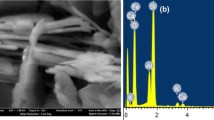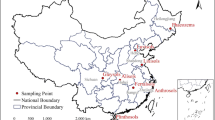Abstract
1,1,1-Trichloro-2,2-bis(p-chlorophenyl)ethane(4,4′-DDT) is a pesticide well-known for its negative health and environmental effects. Despite being banned by a majority of world countries more than 30 years ago, its persistence in the environment is a continuing problem even today. The objective of the study was the investigation of sorption/desorption behavior of 4,4′-DDT in sandy loam soil. The impact of contaminant concentration and age was observed with three different experiments. The sorption percentages at the end of the short time step (8 h) were 50 and 92 %, for initial concentrations 2.26 and 5.28 mg/L, respectively. When freshly spiked soil was subjected to a conventional sorption study, 82 to 99.6 % of the initial aqueous DDT concentrations were sorbed within 24 h. When modeled with a Freundlich isotherm, the log K f was found to be 3.62. After six consecutive 24 h desorption steps, 33 to 96.6 % still remained in the soil. This was more pronounced for soils that had been aged for 60 days. After seven consecutive 24 h desorption steps of aged soil, the percent remaining sorbed to the soil were 44, 64, and 77 %, for 25, 250, and 500 mg/kg, respectively. All results show that 4,4-DDT has a tendency of sorbing to the soil rapidly and showing resistance to desorption. When comparing desorption values, aged soils were seen to desorb less than non-aged soils. This result was attributed to stronger binding to soil with increased contact time.





Similar content being viewed by others
References
Bakir, A., Rowland, S. J., & Thompson, R. C. (2012). Competitive sorption of persistent organic pollutants onto microplastics in the marine environment. Marine Pollution Bulletin, 64, 2782–2789.
Bamforth, S., & Singleton, I. (2005). Review, Bioremediation of polycyclic aromatic hydrocarbons: current knowledge and future directions. Journal of Chemical Technology and Biotechnology, 80, 723–736.
Bidlan, R., & Manonmani, H. K. (2002). Aerobic degradation of dichlorodiphenyltrichloroethane (DDT) by Seratia marcescens DT-1P. Process Biochemistry, 28, 49–56.
Boivin, A., Cherrier, R., & Schiavon, M. (2005). A comparison of five pesticides adsorption and desorption processes in thirteen contrasting field soils. Chemosphere, 61, 668–676.
Boopathy, R. (2000). Factors limiting bioremediation technologies. Bioresource Technology, 74, 63–67.
Boussahel, R., Irinisilmane, H., Harik, D., & Moussaoui, K. M. (2009). Adsorption, kinetics, and equilibrium studies on removal of 4,4-DDT from aqueous solutions using low-cost adsorbents. Chemical Engineering Communications, 196, 1547–1558.
Braida, W. J., White, J. C., Zhao, D., Ferrandino, F. J., & Pignatello, J. J. (2002). Concentration-dependent kinetics of pollutant deosorption from soils. Environmental Toxicology and Chemistry, 21, 2573–2580.
Cao, X., Han, H., Yang, G., Gong, X., & Jing, J. (2011). The sorption behavior of DDT onto sediment in the presence of surfactant cetyltrimethylamonium bromide. Marine Pollution Bulletin, 62, 2370–2376.
Carmo, A. M., Hundal, L. S., & Thompson, M. L. (2000). Sorption of hydrophobic organic compounds by soil materials: application of unit equivalent Freundlich coefficients. Environmental Science and Technology, 34, 4363–4369.
Chen, D., Xing, B., & Xie, W. (2007). Sorption of phenantrene, naphthalene and o-xylene by soil organic matter fractions. Geoderma, 139, 329–335.
Corona-Cruz, A., Gold-Bouchot, G., Gutierrez-Rojas, M., Monroy-Hermosillo, O., & Favela, A. (1999). Anaerobic-aerobic biodegradation of DDT (dichlorodiphenyltrichloroethane) in soils. Bulletin of Environmental Contamination and Toxicology, 63, 219–225.
Dai, R. L., Zhang, G. Y., Gu, X. Z., & Wang, M. K. (2008). Sorption of 1,1,1-trichloro-2,2-bis(p-chlorophenyl) ethane (DDT) by clays and organoclays. Environmental Geochemistry and Health, 30, 479–488.
Ding, J. Y., & Wu, S. C. (1995). Partition coefficients of organochlorine pesticides on soil and on the dissolved organic matter in water. Chemosphere, 30(1), 2259–2266.
Dong, J., Wang, S., & Shang, K. (2010). Simulation of the long-term transfer and fate of DDT in Lanshou, China. Chemosphere, 81, 529–535.
Doong, R. A., & Liao, P. (2001). Determination of organochlorine pesticides and their metabolites in soil samples using headspace solid-phase microextraction. Journal of Chromatography A, 918, 177–188.
Fang, H., Dong, B., Yan, H., Tang, F., & Yu, Y. (2012). Characterization of a bacterial strain capable of degrading DDT congeners and its use in bioremediation of contaminated soil. Journal of Hazardous Materials, 184, 281–289.
Gao, J. P., Maguhn, J., Spitzaurer, P., & Kettrup, A. (1998). Sorption of pesticides in the sediment of the Tefuflsweiher pond (southern Germany). I: Equilibrium assessments, effects of organic carbon content and pH. Water Research, 32(5), 1662–1672.
Ghazali, M., McBean, E., Shen, H., Anderson, W., & Dastous, P. A. (2010). Remediation of DDT-contaminated soil using optimized mixtures of surfactants and a mixing system. Remediation, Autumn, 119–131.
Holoubek, I., Dusek, L., Sanka, M., Hofman, J., Cupr, P., Jarkovsky, J., Zbiral, J., & Klanova, J. (2009). Soil burdens of persistent organic pollutants—their levels, fate and risk. Part I. Variation of concentration ranges according to different soil uses and locations. Environmental Pollution, 157, 3207–3217.
Hu, W., Lu, Y., Wang, T., Luo, W., Zhan, X., Geng, J., Wang, G., Shi, Y., Jiao, W., & Chen, C. (2010). Factors affecting HCH and DDT in soils and watersheds of Beijing reservoirs, China. Environmental Geochemistry Health, 32, 85–94.
Hwang, S., & Cutright, T. J. (2002). Impact of clay minerals and DOM on the competitive sorption/desorption of PAHs. Soil Sediment Contamination Journal, 11, 269–291.
Lackmann, G. M., Schaller, K. H., & Angerer, J. (2004). Organochlorine compounds in breast-fed vs. bottle-fed infants: preliminary results at six weeks of age. Science of the Total Environment, 329, 289–293.
Lalah, J. O., Njogu, S. N., & Wandiga, S. O. (2009). The effects of Mn2+, Ni2+, Cu2+, Co2+ and Zn2+ ions on pesticide adsorption and mobility in a tropical soil. Bulletin of Environmental Contamination and Toxicology, 83, 352–358.
Liu, Z., He, Y., Xu, J., Huang, P., & Jilani, G. (2008). The ratio of clay content to total organic carbon content is a useful parameter to predict adsorption of the herbicide butachlor in soil. Environmental Pollution, 152, 163–171.
Mamy, L., & Barriuso, E. (2007). Desorption and time-dependent sorption of herbicides in soils. European Journal of Soil Science, 58, 174–187.
Montgomery, J. H. (1996). p,p-DDD, p,p-DDE, p,p-DDT physicochemical properties, Groundwater Chemicals Desk Reference (pp. 279–291). New York: Marcekl-Dekker.
Mwangi, K., Boga, H. I., Muigai, A. W., Kiiyukia, C., & Tsanuo, M. K. (2010). Degradation of dichlorodiphenyltrichloroethane (DDT) by bacterial isolates from cultivated and uncultivated soil. African Journal of Microbiology Research, 4(3), 185–196.
Nadeau, L. J., Sayler, G. S., & Spain, J. C. (1998). Oxidation of 1,1,1-trichloro-2,2-bis(4-chlorophenyl)ethane (DDT) by Alcaligenes eutrophus A5. Archives of Microbiology, 171, 44–49.
Neamtu, M., Ciumasu, I. M., Costica, N., Costica, M., Bobu, M., Nicoara, M. N., Catrinescu, C., van Slooten, K. B., & De Alencastro, L. F. (2009). Chemical, biological, and ecotoxicological assessment of pesticides and persistent organic pollutants in the Bahlui River, Romania. Environmental Science Pollution Research, 16, S76–S85.
Oen, A. M. P., Beckingham, B., Ghosh, U., Krusa, M. E., Luthy, R. G., Hartnik, T., Henriksen, T., & Cornelissen, G. (2011). Sorption of organic compounds to fresh and field aged activated carbons in soils and sediments. Environmental Science Technology, 46, 810–817.
Oren, A., & Chefetz, B. (2005). Sorption–desorption behavior of polycyclic aromatic hydrocarbons in upstream and downstream river sediments. Chemosphere, 62, 19–29.
Pan, B., Ning, P., & Xing, B. (2008). Part IV-sorption of hydrophobic organic contaminants. Environmental Science and Pollution Research, 15, 554–564.
Proskauer, E. S. (1992). Contemporary history series, DDT (dichlorodiphenyltrichloroethane) a chemist’s tale. Journal of Chemical Education, 69, 362–365.
Purnomo, A. S., Mori, T., Kamei, I., Nishii, T., & Kondo, R. (2010). Application of mushroom waste medium from Pleurotus ostreatus for bioremediation of DDT-contaminated soil. International Biodeterioration & Biodegradation, 64, 397–402.
Ricking, M., & Schwarzbauer, J. (2012). DDT isomers and metabolites in the environment: an overview. Environmental Chemical Letters, 10, 317–323.
Sadsharshan, S., Naidu, R., Mallavarapu, M., & Bolan, N. (2012). DDT remediation in contaminated soils: a review of recent studies. Biodegradation, 23, 851–863.
Shen, L., & Wania, F. (2005). Compilation, evaluation and selection of physical-chemical property data for organochlorine pesticides. Journal of Chemical Engineering Data, 50, 742–768.
Smit, M. P. J., Grotenhuis, T., Bruning, H., & Rulkens, W. H. (2010). Modeling desorption kinetics of a persistent organic pollutant from field aged sediment using bi-disperse particle size distribution. Journal of Soils and Sediments, 10, 119–126.
Smith, E., Smith, J., Naidu, R., & Juhasz, A. L. (2004). Desorption of DDT from a contaminated soil using cosolvent and surfactant washing in batch experiments. Water, Air, and Soil Pollution, 151, 71–86.
Spark, K. M., & Swift, R. S. (2002). Effect of soil composition and dissolved organic matter on pesticide sorption. Science of the Total Environment, 298, 147–161.
Sporring, S., Bowadt, S., Svensmark, B., & Bjorklund, E. (2005). Comprehensive comparison of classic Soxhlet extraction, ultrasonic extraction, superficial fluid extraction, microwave assisted extraction and accelerated solvent extraction for the determination of polychlorinated biphenyls in soil. Journal of Chromatography A, 1090, 1–9.
Sun, K., Zhao, Y., Gao, B., Liu, X., Zhang, Z., & Xing, B. (2009). Organochlorine pesticides and polybrominated diphenyle ethers in irrigated soils of Beijing China: levels, inventory, fate. Chemosphere, 1199–1205.
Thangavadivel, K., Megharaj, M., Smart, R. S. C., Lesniewski, P. J., Bates, D., & Naidu, R. (2011). Ultrasonic enhanced desorption of DDT from contaminated soils. Water, Air, and Soil Pollution, 217, 115–125.
Thomas, J. E., & Gohil, H. (2011). Microcosm studies on the degradation of o, p'-and p, p'-DDT, DDE and DDD in a muck soil. World Journal of Microbiology and Biotechnology, 27, 619–625.
Van den Berg, H. (2009). Global Status of DDT and its alternatives for use in vector control to prevent disease. Environmental Health Perspective, 117, 1656–1663.
Van den Hoop, M., & Kreule, P. (1999). Sorption kinetics and transformation of DDT in sediment. Water, Air, and Soil Pollution, 110, 57–66.
Vidali, M. (2001). Bioremediation. An overview. Pure and Applied Chemistry, 73, 1163–1172.
Voice, T. C., & Weber, W. J. (1983). Sorption of hydrophobic compounds by sediments, soil and suspended soilds—I. Water Resources, 17, 1433–1441.
Wandiga, S. O. (2001). Use and distribution or organochlorine pesticides: the future in Africa. Pure and Applied Chemistry, 73, 1147–1155.
Wang, G., Zhang, J., Wang, L., Liang, B., Chen, K., Li, S., & Jiang, J. (2010). Co-metabolism of DDT by the newly isolated bacterium, Pseudoxanthomonas sp.wax. Brazilian Journal of Microbiology, 41, 431–438.
Weber, J. B., Wilkerson, G. G., & Reinhardt, C. F. (2004). Calculating pesticide sorption coefficients (Kd) using selected soil properties. Chemosphere, 55, 157–166.
Wenzel, K. D., Manz, M., Hubert, A., & Schuurmann, G. (2002). Fate of POPs (DDX, HCHs, PCBs) in upper soil layers of pine forests. Science Total Environment, 286, 143–154.
Wetterauer, B., Ricking, M., Otte, J. C., Hallare, A. V., Rastall, A., Erdinger, L., Schwarzbauer, J., Braunbeck, T., & Hallert, H. (2012). Toxicity, dioxin-line activities and endocrine effects of DDT metabolites DDA, DDMU DDMS, and DDCN. Environmental Science and Pollution Research, 19, 403–415.
Yuan, G. L., Qin, J. X., Li, J., Lan, X., & Wang, G. (2014). Persistent organic pollutants in soil near the Changwengluozha glacier of the Central Tibetan Plateau, China: their sorption to clays and implication. Science of the Total Environment, 472, 309–315.
Zhao, Y., Yi, X., Li, M., Liu, L., & Ma, W. (2010). Biodegradation kinetics of DDT in soil under different environmental conditions by Lacasse extract from white rot fungi. Biotechnology Bioengineering, 18, 486–492.
Zheng, G., Selvam, A., & Wong, J. W. C. (2012). Enhanced solubilization and desorption of organochlorine pesticides (OCP’s) from soil by oil-swollen micelles formed with a nonionic surfactant. Environmental Science and Technology, 46, 12062–12068.
Zhou, Y., Yan, Z., & Kim, K. (2011). Adsorption behavior and thermodynamic characteristics of p, p'-DDT on expanded graphite. Advanced Materials Research, 287–90, 1653–1658.
Zhu, Y., Liu, H., Xi, Z., Cheng, X., & Xu, X. (2005). Organochlorine pesticides (DDTs and HCHs) in soils from the outskirts of Beijing China. Chemosphere, 60, 77–778.
Author information
Authors and Affiliations
Corresponding author
Rights and permissions
About this article
Cite this article
Erdem, Z., Cutright, T.J. Sorption/desorption of 1,1,1-trichloro-2,2-bis(p-chlorophenyl)ethane(4,4′-DDT) on a sandy loam soil. Environ Monit Assess 187, 24 (2015). https://doi.org/10.1007/s10661-015-4262-7
Received:
Accepted:
Published:
DOI: https://doi.org/10.1007/s10661-015-4262-7




